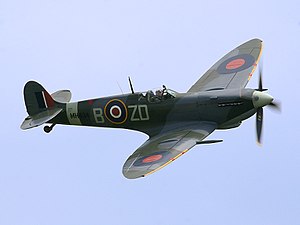Spitfire
| Spitfire | |
|---|---|
 |
|
| Spitfire LF Mk IX, MH434 being flown by Ray Hanna in 2005. This aircraft shot down a Focke Wulf Fw 190 in 1943 while serving with No. 222 Squadron RAF. | |
| Role | Fighter / Photo-reconnaissance aircraft |
| National origin | United Kingdom |
| Manufacturer | Supermarine |
| Designer | R. J. Mitchell |
| First flight | 5 March 1936 |
| Introduction | 4 August 1938 |
| Retired | 1961 Irish Air Corps |
| Primary users |
Royal Air Force Royal Canadian Air Force United States Army Air Forces |
| Produced | 1938–1948 |
| Number built | 20,351 |
| Unit cost |
£12,604 (Estonian order for 12 Spitfires in 1939)
|
| Variants | |
The Supermarine Spitfire is a British single-seat fighter aircraft that was used by the Royal Air Force and many other Allied countries before, during and after World War II. The Spitfire was built in many variants, using several wing configurations, and was produced in greater numbers than any other British aircraft. It was also the only British fighter to be in continuous production throughout the war. The Spitfire continues to be popular among enthusiasts; about 54 remain airworthy, while many more are static exhibits in aviation museums throughout the world.
The Spitfire was designed as a short-range, high-performance interceptor aircraft by R. J. Mitchell, chief designer at Supermarine Aviation Works, which operated as a subsidiary of Vickers-Armstrong from 1928. Mitchell pushed the Spitfire's distinctive elliptical wing (designed by B. Shenstone) to have the thinnest possible cross-section, helping give the aircraft a higher top speed than several contemporary fighters, including the Hawker Hurricane. Mitchell continued to refine the design until his death in 1937, whereupon his colleague Joseph Smith took over as chief designer, overseeing the development of the Spitfire through its multitude of variants.
During the Battle of Britain, from July to October 1940, the Spitfire was perceived by the public to be the main RAF fighter, though the more numerous Hawker Hurricane shouldered a greater proportion of the burden against Nazi Germany's air force, the Luftwaffe. Spitfire units, however, had a lower attrition rate and a higher victory-to-loss ratio than those flying Hurricanes because of its higher performance. Spitfires in general were tasked with engaging Luftwaffe fighters (mainly Messerschmitt Bf 109E series aircraft which were a close match for the Spitfire) during the Battle.
...
Wikipedia
